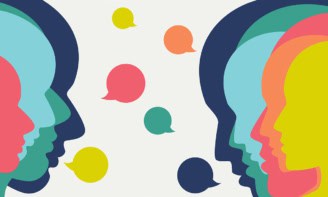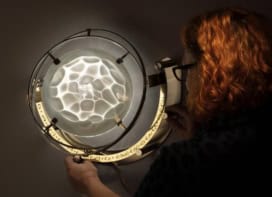Two hundred years after it was written, the Frankenstein story is still haunting, says Robert P Crease

“How,” Mary Godwin asked herself, did I come up with “so very hideous an idea?”
In the summer of 1816, Mary and her lover (soon to be husband) Percy Shelley met Lord Byron in Switzerland. It rained a lot, so rather than hiking as planned they spent time indoors reading ghost stories. At one point Byron suggested they each write their own. At first, Mary had writer’s block, but then recalled a conversation between Percy and Byron about scientific experiments in which researchers caused parts of animals to flinch by applying electricity, which then made them speculate about the principle of life. That night Mary had a dream in which a technician sent a spark into an assemblage of body parts. The thing began to move, and then opened its eyes.
The next day Mary told her companions she had an idea.
Out of control
That’s the story Mary Shelley told of the origin of Frankenstein in her introduction to its second edition (1831). Thanks to two centuries of theatre and film adaptations, most people know the basic plot, which centres on an out-of-control monster built by a well-meaning but careless scientist named Victor Frankenstein. The story is now embedded in our language. The prefix “Franken-”, as in “Frankenfoods” and “Frankenfish”, is often used to create a charged word referring to a terrible thing that should not have been created because it is an unnatural product of rampant consumerism. Frankenwords are catchy, wave a red flag, provoke fear, and seem to endow those who use them with unclouded moral judgement.
But the story that unfolds in Shelley’s novel is not so simple.
In 2014 two humanities scholars at the University of New Mexico published an article in Science and Engineering Ethics (21 1139) that envisioned Victor Frankenstein submitting his research to an institutional review board (IRB), or panel of the sort now mandatory in the US for research involving human or animal subjects. “Had Frankenstein had to submit an IRB proposal,” wrote the authors, “tragedy may have been averted, for he would have been compelled to consider the consequences of his experiment and acknowledge, if not fulfil, his concomitant responsibilities to the creature that he abandoned and left to fend for itself.”
The article cleverly exhibits Frankenstein’s potential for teaching contemporary research ethics. At the same time, though, the article exemplifies the familiar but erroneous way in which the story is understood: as a tale about the creator and the creation. To determine the ethics of the experiment, the authors looked into possible carelessness or ill intent on the part of Frankenstein, and the potential for the creature to do harm.
Numerous adaptations of the story reflect that version too. In the 1931 film Frankenstein, starring Boris Karloff, the creator unwittingly installs an abnormal brain in the creature. The creature, a property destroyer and serial killer, is evil from the start.
Other interpretations, though, blame Victor Frankenstein, the monster’s creator. At one point in Shelley’s story, he calls the monster “my own spirit let loose”. In these psychological interpretations, Victor’s act is motivated by his internal demons, such as the trauma of losing his mother before he leaves for university. “Knowledge is the awareness that Frankenstein is not the monster,” runs a joke. “Wisdom is the awareness that Frankenstein is the monster.”
Certain other interpretations blame Victor’s ambition: to create life in the lab without thinking of the rest of world. Such ecological interpretations, behind “Frankenfood” language, find the monster to symbolize the breakdown of responsible human stewardship of nature.
In a 2011 article in the Breakthrough Journal entitled “Love your monsters: why we must care for our technologies as we do our children”, the French philosopher Bruno Latour proposed that the moral of Frankenstein is that technologies should not be unleashed without human guidance. The scientists who discover things like nuclear fission, for instance, are responsible for its applications. This is a parental interpretation: constantly care for your creations or you’re a bad parent!
But Shelley’s story, read attentively, wrecks such interpretations. She leaves no indication the beast has anything but a normal brain. The creature himself gives a persuasive reason for his behaviour: “I was benevolent and good; misery [his rejection by humans] made me a fiend.” Shelley’s story indeed carries a shockingly contemporary message: the creature is the extreme refugee, unable to assimilate into the country where he’s thrown without his consent, whose inhabitants not only reject but vilify him.
In Shelley’s story, too, Victor’s ambitions are not outlandish but shared by the professors who taught him science in the first place, who seek to “penetrate into the recesses of nature, and show how she works in her hiding places”. Like them, he is thrilled, saying: “None but those who have experienced them can conceive of the enticements of science.”
Nor was the science implausible. “Mary Shelley based Victor Frankenstein’s attempt to create a new species from dead organic matter through the use of chemistry and electricity on the most advanced scientific research of the early 19th century,” writes Shelley’s biographer Anne K Mellor. “Her vision of the isolated scientist discovering the secret of life is no mere fantasy but a plausible prediction of what science might accomplish.”
The critical point
The evil that erupts in Shelley’s story therefore cannot be blamed entirely on electricity, careless scientists, or an out-of-control creation, but also on the climate in which Victor conducts his research. It therefore recalls another contemporary predicament: that of bank employees whose managers instruct them to handle their accounts ethically but who must work in a banking climate with overwhelming incentives not to do so. For physicists and other scientists, Shelley’s story rings an alarm bell, not because of some breakdown in the system – bad behaviour, brains, or breeding – but because nothing broke down.
Now that’s a hideous idea.



